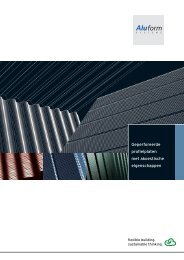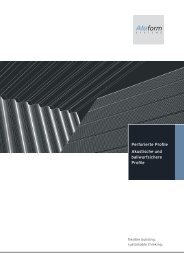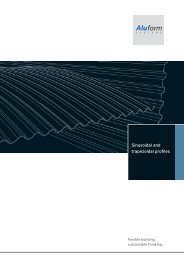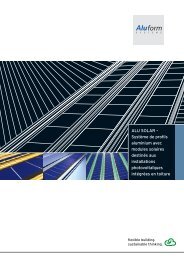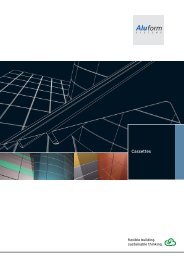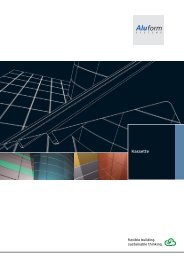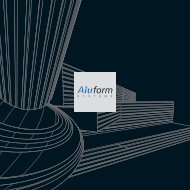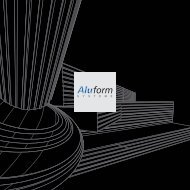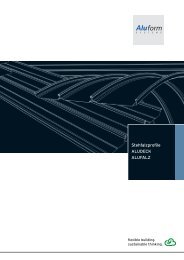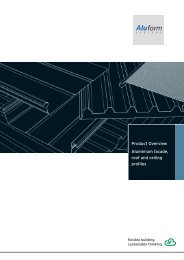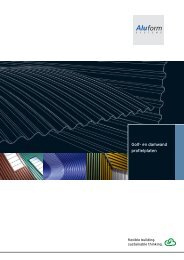ALU SOLAR - Aluform System GmbH & Co. KG
ALU SOLAR - Aluform System GmbH & Co. KG
ALU SOLAR - Aluform System GmbH & Co. KG
Create successful ePaper yourself
Turn your PDF publications into a flip-book with our unique Google optimized e-Paper software.
<strong>ALU</strong> <strong>SOLAR</strong> –<br />
Aluminium profile<br />
system with solar<br />
modules for roofintegrated<br />
photovoltaic<br />
systems<br />
flexible building.<br />
sustainable thinking.
PRODUCTS<br />
<strong>ALU</strong> <strong>SOLAR</strong> – the resource-efficient synergy of<br />
architecture, function and energy regeneration<br />
<strong>Aluform</strong> standing seam profile<br />
<strong>ALU</strong>FALZ pro 65/600<br />
Mounting of the panels<br />
Crimping of<br />
panels<br />
<strong>Aluform</strong> standing seam profile<br />
<strong>ALU</strong>FALZ 65/500<br />
Installation direction<br />
<strong>ALU</strong> <strong>SOLAR</strong><br />
connects modern<br />
architectural design<br />
with the solar energy<br />
generation<br />
Aluminium is a modern building material,<br />
which more than any other material<br />
combines the variety of forms, long life<br />
time and design freedom. Due to these<br />
qualities aluminium is broadly applied to<br />
panelling of roofs. In connection with<br />
amorphous UNI-<strong>SOLAR</strong> ® silicon thin-layer<br />
modules, <strong>Aluform</strong> <strong>SOLAR</strong> profiles offer<br />
new opportunities for contemporary<br />
architecture and the efficient use of solar<br />
energy.<br />
Aluminium standing seam profiles possess<br />
exceptional advantages due to the approved<br />
profiling as well as the positive qualities of<br />
aluminium alloy AlMn1Mg0.5, since it is:<br />
z very light,<br />
z solid and stable,<br />
z maintenance-free,<br />
z durable,<br />
z aesthetic,<br />
z non-combustible,<br />
z easy to process and<br />
z easy to assemble.<br />
<strong>Aluform</strong> standing seam profiles are prefabricated<br />
folding systems for the application<br />
in the roof area. Due to the elaborate and<br />
optimal joining technology, they can be<br />
quickly and easily installed. The <strong>Aluform</strong><br />
standing seam profile 65/500 and<br />
65/600 pro has been developed specially<br />
for the application in the photovoltaic<br />
systems integrated in the construction.<br />
761 n
PRODUCTS<br />
<strong>ALU</strong> <strong>SOLAR</strong> – amorphous solar thin-layer cells are flexible,<br />
lighter, more efficient and possess higher performance<br />
Total thickness of the<br />
multi junction cell<br />
The development of the new <strong>ALU</strong> <strong>SOLAR</strong><br />
roof profiles is based on the innovative and<br />
flexible solar products of UNI-<strong>SOLAR</strong> ® ,<br />
which ideally harmonise with the light and<br />
durable <strong>Aluform</strong> roof system <strong>ALU</strong>FALZ.<br />
Transparent contact layer<br />
Blue cell<br />
Green cell<br />
Red cell<br />
Black reflective<br />
foil layer<br />
Flexible stainless steel<br />
supporting material<br />
The exceptional Triple Junction Technology<br />
uses the blue, green and red parts of the<br />
sunlight in different layers of the solar cell.<br />
As a result a higher degree of efficiency<br />
is reached as with crystalline solar cells<br />
in case of minor solar radiation and of the<br />
diffuse light. Even in case of partly shadowing,<br />
electricity generation is still possible<br />
due to the cells interconnected via bypass<br />
diodes.<br />
Relative intensity<br />
Absorption of the light spectrum as an example of the<br />
Triple Junction Technology<br />
1.0<br />
0.8<br />
0.6<br />
0.4<br />
0.2<br />
0<br />
Total triple junction cell<br />
Blue absorbing<br />
cell<br />
Green absorbing<br />
cell<br />
Red absorbing<br />
cell<br />
Another advantage of the amorphous<br />
thin-layer solar cells – in comparison with<br />
crystalline cells – is the constant power<br />
output also in case of increasing temperatures.<br />
Moreover, crystalline solar modules<br />
result in considerable efficiency loss. In<br />
contrast our <strong>ALU</strong> <strong>SOLAR</strong> modules are<br />
provided with the complete performance<br />
ability, when this is most necessary.<br />
As in comparison with crystalline solar<br />
cells, the thickness of thin-layer cells is<br />
considerably lower, an explicitly minor<br />
expenditure of materials may result furthermore.<br />
Also the process temperatures<br />
during production are much lower. This<br />
results in a remarkably better energy<br />
balance in comparison with the traditional<br />
crystalline solar products.<br />
Wh/Wp<br />
0.8<br />
0.75<br />
0.7<br />
0.65<br />
0.6<br />
0.55<br />
0.5<br />
300<br />
400 500 600 700 800 900<br />
Wave length, mm<br />
Performance record in case of increasing temperatures<br />
Place: Urbino, Italy (2003-2004)<br />
20 25 30 35 40 45 50 55 60 65 T (°C)<br />
(poly)<br />
Linear (poly)<br />
(mono)<br />
UNI-<strong>SOLAR</strong> ® : More efficient and ecological production process<br />
based on a lower expenditure of material and energy<br />
Process temperatures<br />
1000 °C<br />
to<br />
1500 °C<br />
Linear (mono)<br />
UNI-<strong>SOLAR</strong> ® (amorphous)<br />
Linear (UNI-<strong>SOLAR</strong> ® (amorphous))<br />
Material expenditure<br />
≤ 300 μm<br />
300 °C<br />
1 μm<br />
Thin-layer cells Crystalline cells Thin-layer cells Crystalline cells
PRODUCTS<br />
<strong>ALU</strong> <strong>SOLAR</strong> – the symbioses of Triple Junction<br />
Technology and roof-integrated photovoltaic systems<br />
The connection of a durable aluminium<br />
roof with a light, amorphous solar module<br />
integrated in the aluminium profile results<br />
in an innovative and brilliant symbiosis.<br />
Particularly large to very large flat roofs<br />
are covered with our industrially manufactured<br />
<strong>Aluform</strong> standing seam profiled<br />
panels. Crystalline solar modules are<br />
hardly economically applicable without<br />
elevation on the corresponding roof<br />
inclinations.<br />
kWh/kWp<br />
<strong>Co</strong>mparative display of calculated – actual energy yield<br />
Place: Dresden<br />
Source: UNI-<strong>SOLAR</strong> ®<br />
1 2 3 4 5 6 7 8 9 10 11 12<br />
Actual energy yield<br />
Calculated energy yield<br />
(PV SOL)<br />
Radiation value: 987 kWh/m 2<br />
<strong>System</strong> capacity: 786 kWp<br />
Angle of inclination: 3°<br />
Installation: 2007<br />
Specific annual energy yield<br />
prognosticated: 861 kWh/kWp<br />
measured:<br />
864 kWh/kWp<br />
Months 2008<br />
Due to the Triple Junction Technology the<br />
energetic utilisation has enormously<br />
increased also for flat roof inclinations.<br />
Therefore, heavy and expensive elevation<br />
systems are not necessary anymore.<br />
Average annual yield (2004-2006)<br />
Place: Santa Cruz, California, USA<br />
Source: Solarquest Report<br />
UNI-<strong>SOLAR</strong> ® 30° inclination<br />
UNI-<strong>SOLAR</strong> ® 3° inclination<br />
1294<br />
1654<br />
Also from an architectural point of view<br />
a roof-integrated photovoltaic system is a<br />
Crystalline 30° inclination<br />
1268<br />
benefit. Thus, the planned geometry of a<br />
building can be aligned with the desired<br />
environmentally friendly generation of<br />
electricity.<br />
Also in case of roof renovations, there is<br />
often a request to win energy by means of<br />
photovoltaic systems. However, limits are<br />
set with regard to static aspects. This<br />
problem can be solved by means of the<br />
application of the light <strong>Aluform</strong> <strong>SOLAR</strong><br />
0 500 1000 1500<br />
2000 in kWh/kWp<br />
roof systems because the weight of<br />
effected simultaneously with the assembly<br />
<strong>ALU</strong> <strong>SOLAR</strong>, including the laminate, is only of the roof panel. In comparison to the<br />
approx. 6.5 kg/m 2 . Besides, by means of assembly costs of traditional crystalline<br />
the direct adhesion of the solar laminate modules, including necessary substructure,<br />
with the aluminium profiled roof panels, the installation time as well as the resulting<br />
costs are also considerably reduced<br />
additional critical wind loads have no<br />
impact on the roof construction.<br />
here.<br />
The aluminium panels are delivered<br />
together with the solar laminates on site.<br />
The assembly of the solar system is
<strong>Aluform</strong> – always part of the future<br />
Photo: fotolia<br />
<strong>ALU</strong> <strong>SOLAR</strong> opens up new perspectives<br />
for autonomous architectural design and future-orientated construction<br />
Photovoltaics is the key technology for the<br />
effective energy generation. With the new<br />
<strong>ALU</strong> <strong>SOLAR</strong> roof systems new perspectives<br />
open up for creative and environmentally<br />
conscious construction. Architects and<br />
designers can develop and realise buildings<br />
aligned with sustainability.<br />
The aesthetics of the architecture of aluminium<br />
profiles is functionally connected with<br />
the effect of the environmentally friendly<br />
electricity generation. Form and function<br />
comply with the environmentally conscious<br />
philosophy of the modern and future-orientated<br />
construction.<br />
The application of amorphous silicon thinlayer<br />
modules to the roofs makes a various<br />
use of <strong>Aluform</strong> standing seam profiles,<br />
which can be integrated with the solar technology,<br />
in case of greatest possible design<br />
freedom and efficient use of the solar<br />
energy.<br />
The efficiency of amorphous solar modules<br />
always remains constant – in comparison<br />
with crystalline ones – in spite of fluctuating<br />
temperatures. Thus, <strong>ALU</strong> <strong>SOLAR</strong> profiles<br />
connect the approved quality of the highvalue<br />
aluminium profiles for lightweight<br />
roofs with the advantages of solar energy<br />
generation in a harmonious manner.<br />
The solar modules that are permanently<br />
applied to the aluminium profile as a foil are<br />
easily and efficiently applicable. Beside the<br />
function, they transmit the distinctive, autonomous<br />
architectural design to each roof.<br />
Due to the lightness of the solar modules of<br />
the roof system, architects and designers<br />
have a larger creative scope for individual<br />
design ideas and environmentally friendly<br />
energetic solutions.<br />
flexible building.<br />
sustainable thinking.<br />
761 n
<strong>Aluform</strong> <strong>System</strong> <strong>GmbH</strong> & <strong>Co</strong>. <strong>KG</strong><br />
Dresdener Straße 15<br />
D-02994 Bernsdorf<br />
Phone: +49 (0) 35723 99-0<br />
Fax: +49 (0) 35723 99-401<br />
Email: info@aluform.de<br />
www.aluform.com<br />
© www.mkwa.de<br />
Technical Data<br />
Laminates: PVL 68 PVL 128 PVL 136 PVL 144<br />
Max. nominal capacity (Pmax):<br />
(Production tolerance +/- 5%)<br />
68 Wp 128 Wp 136 Wp 144 Wp<br />
Dimensions (LxW): 2849 x 394 mm 5486 x 394 mm 5486 x 394 mm 5486 x 394 mm<br />
Ideal roof inclination 3° - 20° 3° - 20° 3° - 20° 3° - 20°<br />
Max. roof inclination (Additional<br />
screw connection is necessary)<br />
60° 60° 60° 60°<br />
Voltage at Pmax (Vmp): 16.5 V 33 V 33 V 33 V<br />
Current at Pmax (Imp): 4.1 A 3.88 A 4.13 A 4.36 A<br />
Short-circuit current (Isc): 5.1 A 4.8 A 5.1 A 5.3 A<br />
Open circuit voltage (Voc): 23.1 V 47.6 V 46.2 V 46.2 V<br />
Maximum series fuse rating: 8 A 8 A 8 A 8 A<br />
Note:<br />
In the first 8 - 10 weeks of the operation the electrical parameters may exceed the specified values (power output +15 %, operating voltage +11 %, operating current +4 %).<br />
The electrical specifications refer to measurements that were performed under standard test conditions (1000 W/m 2 irradiance, AM1.5, cell temperature 25 °) after stabilisation.<br />
(Source: Data sheets UNI-<strong>SOLAR</strong> ® )



